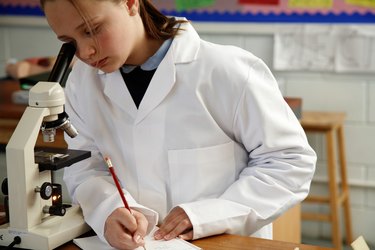
Aerobic respiration is a biological process that takes energy from glucose and other organic compounds to create a molecule called Adenosine TriPhosphate (ATP). ATP is then used as energy by nearly every cell in the body -- the largest user being the muscular system. Aerobic respiration has four stages: Glycolysis, formation of acetyl coenzyme A, the citric acid cycle, and the electron transport chain.
Glycolysis
Video of the Day
The first step of aerobic respiration is glycolysis. This step takes place within the cytosol of the cell, and is actually anaerobic, meaning it does not need oxygen. During glycolysis, which means breakdown of glucose, glucose is separated into two ATP and two NADH molecules, which are used later in the process of aerobic respiration.
Video of the Day
Formation of Acetyl Coenzyme A
The next step in aerobic respiration is the formation of acetyl coenzyme A. In this step, pyruvate is brought into the mitochondria to be oxidized, creating a 2-carbonacetyl group. This 2-carbon acetyl group then binds with coenzyme A, forming acetyl coenzyme A. The acetyl coenzyme A is then brought back into the mitochondria for use in the next step.
Citric Acid Cycle
The third step of aerobic respiration is called the citric acid cycle -- it is also called the Krebs cycle. Here, oxaloacetate combines with the acetyl coenzyme A, creating citric acid -- the name of the cycle. Two turns of the citric acid cycle are required to break down the original acetyl coenzyme A from the single glucose molecule. These two cycles create an additional two ATP molecules, as well as six NADH and two FADH molecules, all which are used later.
Electron Transport Chain
The final step in aerobic respiration is the electron transport chain. In this phase, the NADH and FADH donate their electrons to make large amounts of ATP. One molecule of glucose creates a total of 34 ATP molecules.